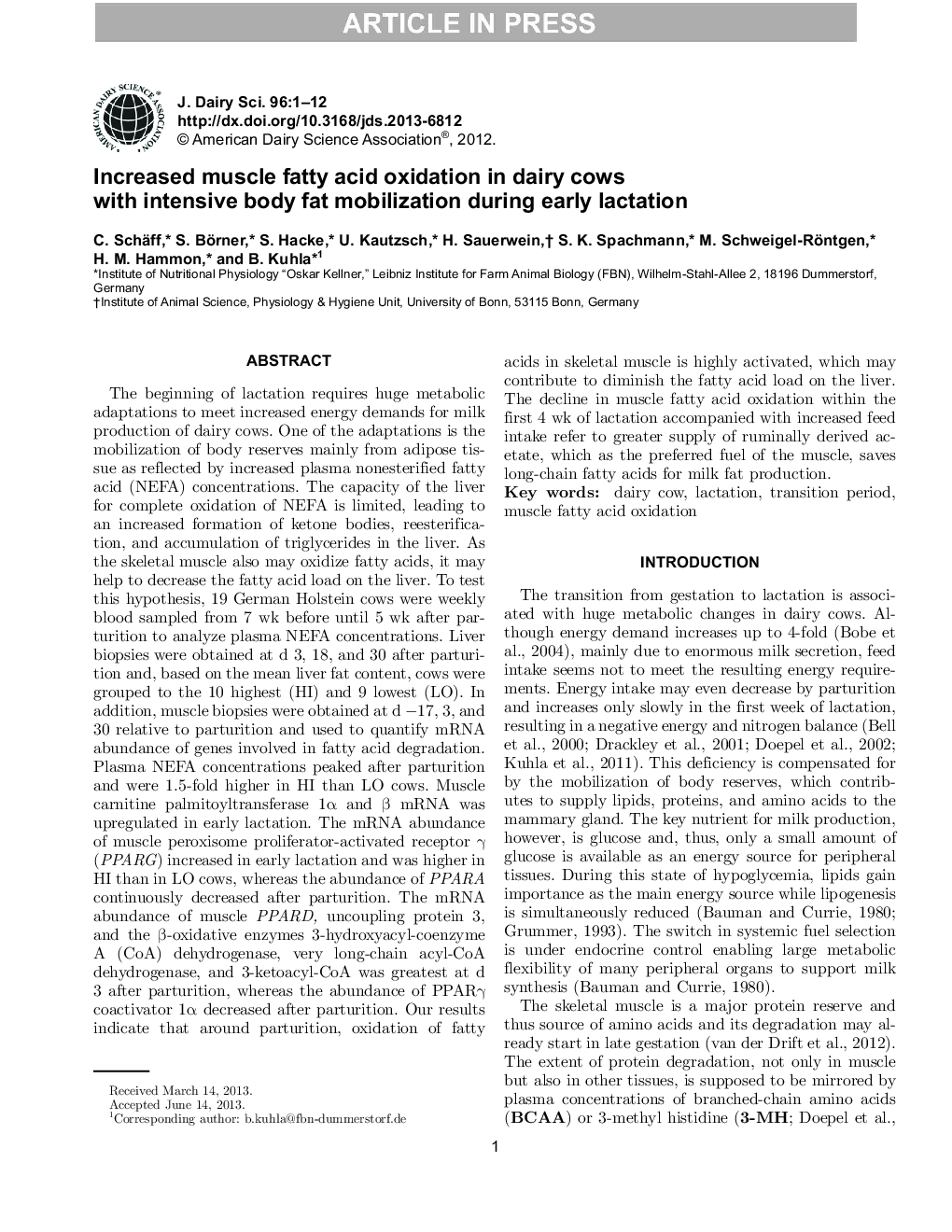| کد مقاله | کد نشریه | سال انتشار | مقاله انگلیسی | نسخه تمام متن |
|---|---|---|---|---|
| 10975918 | 1108037 | 2013 | 12 صفحه PDF | دانلود رایگان |
عنوان انگلیسی مقاله ISI
Increased muscle fatty acid oxidation in dairy cows with intensive body fat mobilization during early lactation
ترجمه فارسی عنوان
افزایش اکسیداسیون اسید چرب ماهی در گاوهای شیری با بسیج شدت چربی بدن در اوایل شیردهی
دانلود مقاله + سفارش ترجمه
دانلود مقاله ISI انگلیسی
رایگان برای ایرانیان
کلمات کلیدی
گاو شیری، شیردهی، دوره گذار، اکسیداسیون اسید چرب ماهیچه،
موضوعات مرتبط
علوم زیستی و بیوفناوری
علوم کشاورزی و بیولوژیک
علوم دامی و جانورشناسی
چکیده انگلیسی
The beginning of lactation requires huge metabolic adaptations to meet increased energy demands for milk production of dairy cows. One of the adaptations is the mobilization of body reserves mainly from adipose tissue as reflected by increased plasma nonesterified fatty acid (NEFA) concentrations. The capacity of the liver for complete oxidation of NEFA is limited, leading to an increased formation of ketone bodies, reesterification, and accumulation of triglycerides in the liver. As the skeletal muscle also may oxidize fatty acids, it may help to decrease the fatty acid load on the liver. To test this hypothesis, 19 German Holstein cows were weekly blood sampled from 7 wk before until 5 wk after parturition to analyze plasma NEFA concentrations. Liver biopsies were obtained at d 3, 18, and 30 after parturition and, based on the mean liver fat content, cows were grouped to the 10 highest (HI) and 9 lowest (LO). In addition, muscle biopsies were obtained at d â17, 3, and 30 relative to parturition and used to quantify mRNA abundance of genes involved in fatty acid degradation. Plasma NEFA concentrations peaked after parturition and were 1.5-fold higher in HI than LO cows. Muscle carnitine palmitoyltransferase 1α and β mRNA was upregulated in early lactation. The mRNA abundance of muscle peroxisome proliferator-activated receptor γ (PPARG) increased in early lactation and was higher in HI than in LO cows, whereas the abundance of PPARA continuously decreased after parturition. The mRNA abundance of muscle PPARD, uncoupling protein 3, and the β-oxidative enzymes 3-hydroxyacyl-coenzyme A (CoA) dehydrogenase, very long-chain acyl-CoA dehydrogenase, and 3-ketoacyl-CoA was greatest at d 3 after parturition, whereas the abundance of PPARγ coactivator 1α decreased after parturition. Our results indicate that around parturition, oxidation of fatty acids in skeletal muscle is highly activated, which may contribute to diminish the fatty acid load on the liver. The decline in muscle fatty acid oxidation within the first 4 wk of lactation accompanied with increased feed intake refer to greater supply of ruminally derived acetate, which as the preferred fuel of the muscle, saves long-chain fatty acids for milk fat production.
ناشر
Database: Elsevier - ScienceDirect (ساینس دایرکت)
Journal: Journal of Dairy Science - Volume 96, Issue 10, October 2013, Pages 6449-6460
Journal: Journal of Dairy Science - Volume 96, Issue 10, October 2013, Pages 6449-6460
نویسندگان
C. Schäff, S. Börner, S. Hacke, U. Kautzsch, H. Sauerwein, S.K. Spachmann, M. Schweigel-Röntgen, H.M. Hammon, B. Kuhla,
